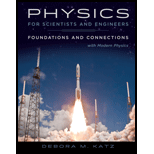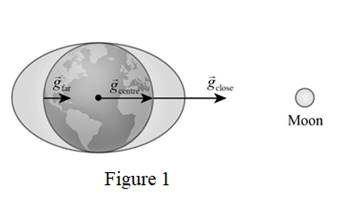
Concept explainers
(a)
Moon’s gravitational field at the side of Earth which is facing Moon.
(a)
Answer to Problem 55PQ
Moon’s gravitational field at the side of Earth facing Moon is
Explanation of Solution
Write the equation to find the gravitational field due to Moon at a distance of Moon-Earth distance minus radius of Earth.
Here,
Write the expression to find
Here,
Use the expression for
Conclusion
Substitute
Therefore, Moon’s gravitational field at the side of Earth facing Moon is
(b)
Moon’s gravitational field at the side of Earth facing away from Moon.
(b)
Answer to Problem 55PQ
Moon’s gravitational field at the side of Earth facing away from Moon is
Explanation of Solution
Write the equation to find the gravitational field due to Moon at a distance of Moon-Earth distance plus radius of Earth.
Write the expression for
Substitute the expression for
Conclusion:
Substitute
Therefore, Moon’s gravitational field at the side of Earth facing away Moon is
(c)
The gravitational field of Moon at the center of Earth.
(c)
Answer to Problem 55PQ
Moon’s gravitational field at the center of Earth is
Explanation of Solution
Write the equation to find the gravitational field due to Moon.
Conclusion:
Substitute
Therefore, Moon’s gravitational field at center of Earth is
(d)
Sketch Earth and include the three vectors from parts (a) through (c).
(d)
Answer to Problem 55PQ
Sketch of Earth and the three vectors from parts (a) through (c) is shown in Figure 1.
Explanation of Solution
Figure 1 shows the sketch of the Earth and the magnitude and direction of the gravitational field vectors found in part (a), (b) and (c).

Conclusion:
Therefore, Sketch of Earth and the three vectors from parts a through c is shown in Figure 1.
(e)
The reason why there are two tides a day on most places on Earth due to Moon.
(e)
Answer to Problem 55PQ
There are two tides a day on most places on Earth due to Moon because the force is larger on bodies of water closer to Moon and smaller on bodies of water on far side of Earth.
Explanation of Solution
Figure below shows the Earth and Moon. High tides and low tides on either side of Earth are due to the lunar activity on Earth. The gravitational pull by Moon on Earth causes high tide and low tide.

The force of Moon is large at water bodies which are close to Moon and lowest on water bodies which are far away. Thus the amplitude or strength of tides is dependent on the distance of the water body and Moon. This is the reason for two types of tides on Earth.
Conclusion:
Therefore, there are two tides a day on most places on Earth due to Moon because the force is larger on bodies of water closer to Moon and smaller on bodies of water on far side of Earth.
Want to see more full solutions like this?
Chapter 7 Solutions
Webassign Printed Access Card For Katz's Physics For Scientists And Engineers: Foundations And Connections, 1st Edition, Single-term
- Two complex values are z1=8 + 8i, z2=15 + 7 i. z1∗ and z2∗ are the complex conjugate values. Any complex value can be expessed in the form of a+bi=reiθ. Find r and θ for z1z2∗. Find r and θ for z1/z2∗? Find r and θ for (z1−z2)∗/z1+z2∗. Find r and θ for (z1−z2)∗/z1z2∗ Please explain all steps, Thank youarrow_forwardAn ac series circuit consists of a voltage source of frequency 60 Hz and voltage amplitude V, a 505-Ω resistor, and a capacitor of capacitance 7.2 μF. What must be the source voltage amplitude V for the average electrical power consumed in the resistor to be 236 W? There is no inductance in the circuit.arrow_forwardAn L−R−C series circuit has R= 280 Ω . At the frequency of the source, the inductor has reactance XLL= 905 Ω and the capacitor has reactance XC= 485 Ω . The amplitude of the voltage across the inductor is 445 V . What is the amplitude of the voltage across the resistor and the capacitor? What is the voltage amplitude of the source? What is the rate at which the source is delivering electrical energy to the circuit?arrow_forward
- A 0.185 H inductor is connected in series with a 98.5 Ω resistor and an ac source. The voltage across the inductor is vL=−(12.5V)sin[(476rad/s)t]vL. Derive an expression for the voltage vR across the resistor. Express your answer in terms of the variables L, R, VL (amplitude of the voltage across the inductor), ω, and t. What is vR at 2.13 ms ? Please explain all stepsarrow_forwardA worker lifts a box under the following conditions:Horizontal distance (H): 30 cmInitial height (V): 60 cmVertical travel (D): 50 cmTorso rotation (A): 30°Frequency: 3 times/minute for 1 hourGrip: Good Question:What is the RWL for this task?What does this value mean in terms of occupational safety?arrow_forwardCan someone helparrow_forward
- Can someone help mearrow_forward3. Four identical small masses are connected in a flat perfect square. Rank the relative rotational inertias (IA, IB, IC) about the three axes of rotation shown. Axes A and B are in the plane of the square, and axis C is perpendicular to the plane, through mass m1. ΙΑ IB m2 m1 m3 Ic m4 (a) IAarrow_forwardConsider the circuit shown in the figure below. (Assume L = 5.20 m and R2 = 440 Ω.) (a) When the switch is in position a, for what value of R1 will the circuit have a time constant of 15.4 µs? (b) What is the current in the inductor at the instant the switch is thrown to position b?arrow_forwardCan someone helparrow_forwardCan someone help mearrow_forwardA particle in a box between x=0 and x=6 has the wavefunction Psi(x)=A sin(2πx). How muchenergy is required for the electron to make a transition to Psi(x)= A’ sin(7π x/3). Draw anapproximate graph for the wavefunction. Find A and A'arrow_forwardarrow_back_iosSEE MORE QUESTIONSarrow_forward_ios
 Physics for Scientists and Engineers: Foundations...PhysicsISBN:9781133939146Author:Katz, Debora M.Publisher:Cengage Learning
Physics for Scientists and Engineers: Foundations...PhysicsISBN:9781133939146Author:Katz, Debora M.Publisher:Cengage Learning Principles of Physics: A Calculus-Based TextPhysicsISBN:9781133104261Author:Raymond A. Serway, John W. JewettPublisher:Cengage Learning
Principles of Physics: A Calculus-Based TextPhysicsISBN:9781133104261Author:Raymond A. Serway, John W. JewettPublisher:Cengage Learning Physics for Scientists and Engineers with Modern ...PhysicsISBN:9781337553292Author:Raymond A. Serway, John W. JewettPublisher:Cengage Learning
Physics for Scientists and Engineers with Modern ...PhysicsISBN:9781337553292Author:Raymond A. Serway, John W. JewettPublisher:Cengage Learning Physics for Scientists and EngineersPhysicsISBN:9781337553278Author:Raymond A. Serway, John W. JewettPublisher:Cengage Learning
Physics for Scientists and EngineersPhysicsISBN:9781337553278Author:Raymond A. Serway, John W. JewettPublisher:Cengage Learning Physics for Scientists and Engineers, Technology ...PhysicsISBN:9781305116399Author:Raymond A. Serway, John W. JewettPublisher:Cengage Learning
Physics for Scientists and Engineers, Technology ...PhysicsISBN:9781305116399Author:Raymond A. Serway, John W. JewettPublisher:Cengage Learning Glencoe Physics: Principles and Problems, Student...PhysicsISBN:9780078807213Author:Paul W. ZitzewitzPublisher:Glencoe/McGraw-Hill
Glencoe Physics: Principles and Problems, Student...PhysicsISBN:9780078807213Author:Paul W. ZitzewitzPublisher:Glencoe/McGraw-Hill





